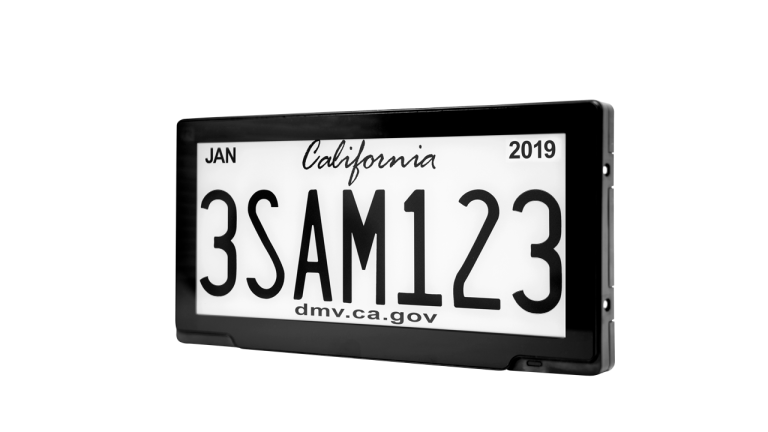Revving The Engine For Digital Licenses

There’s a road — literally — from analog to digital.
Think stamped metal translated into bits and bytes, helping to transform a part of the auto industry that has been around for more than a hundred years: license plates.
In the process, might the age-old frustration of standing in line at the DMV, shuffling papers, paying by (gasp!) paper check all be transformed along the way?
Reviver Auto seeks to bring the license plate into the digital age via its rPlate, which acts as a digital display, tied, of course, to license plate numbers, but with an eye on connectivity. The plate, available in California and due to be rolled out in other states through 2018, is a self-lit LCD screen with a display that can be changed to, for example, showcase advertising along the (government-issued) license plate number.
Beyond the technology and the plate lies concept. In an interview with PYMNTS, CEO and Founder of Reviver Auto Neville Boston said that for the firm, which traces its genesis to 2009, the “initial thought process was simplifying the registration process. It’s onerous. Anybody that you know that talks about the DMV … there’s not necessarily a positive way in which they speak about [the experience].”
Thus the firm has sought — with businesses running fleets in mind and also, of course, for individual drivers — to develop technology that can be used for registration, toll payments and even parking meter payments, tying it all to rConnect, a platform that helps manage the plate’s functionality.
“It’s about fixing a broken system with technology,” he said, “and then working in concert with the DMV or DOT to that desired end.”
He noted that among the problems the government and private sector may both face in this arena is that state DMVs, such as those in California, “do not do bulk registration … their systems aren’t built for that.” Thus, for a business that has several vehicles out on the road, there are several individual registrations that have to be paid — instead of being paid all at once.
“You’ve got legacy systems,” Boston said of government agencies, “that are very difficult to update, to the point where you will have a system that people have to come back out of retirement to fix when they are broken.” Thus, more wasted time and manual processes (and, for the agencies, more staff on hand) than either side might like. Shave the time off processing, and shave the physical details, such as decals and stickers, and cost savings accrue.
The conversation, as it often does with technology, turned to security. Boston noted that, with the traditional and entrenched methods, “your registration is sent out to an address.” With snail mail, mistakes happen; documentation might be sent to the wrong address or intercepted so that the unknown receiving party “has access to all your data.”
Reviver Auto envisions a registration process where “you would be on a secure portal doing registration on our app, and you’d have the same security that you would have doing online banking. The transaction of information from our site to the DMV and then back [to the individual] would be extremely secure.”
Boston noted that within the plate there is a GPS unit, which means the plate “knows” where it is. “The focus of that,” he said, “was initially for businesses. For consumers,” he continued, the option is there to have the GPS on or off.
As far as registration, drivers would have a dashboard linking to the DMV, so, when going through the registration process, queries would be based on vehicle-specific info — such as the VIN number of the vehicle, the license plate number — and then, once the DMV authenticates the registrant, that information would be sent back to the plate. “The plate would light up, and then you would have the registration info and the new license plate numbers,” said Boston.
From start to finish, the time to get a new plate into existence takes minutes — a stark contrast to the hours spent on line at the DMV. Additional messaging functions would include Amber alerts, specialty plates or, for businesses, advertising.
For businesses, “when you have vehicles that are all over the state and are traveling hither and yon, the ability to know from a computer or from the laptap or tablet that you can update registration without having to physically touch the vehicle is huge. Being able to know where your payments lie and being able to regulate that to a process is a big advantage. Also, as a business, being able to target messages based on location” translates to an advantage where a prospective customer can be engaged in way that they might not have been before.
The company recently raised $11.1 million in financing. “As we broaden out,” Boston said, “we start talking about being able to do bridge tolls,” enabled by RFID tags already in the plates, and being able to interface with parking meters. The funds will go toward staffing up both hardware and software resources and igniting targeted marketing campaigns throughout the rest of the year.
The firm aims to have 100,000 digital license plates out on the road by the end of 2018, with pilot programs in place in Texas and Florida. Reviver Auto is also working with another six states. “What we are looking at is to be in 10 states by the end of 2018” — from the East Coast to the West Coast, from Michigan down to Georgia, the CEO told PYMNTS.
International opportunities abound, as the executive stated that “we have been inundated from South Africa to the UAE” and across Europe and Australia with “tremendous interest in having the plates. The ability to expand internationally,” he said, “is basically sealed.”
The biggest challenge going to market has been in keeping up with the demand for the technology.
“It’s an exciting problem to have,” Boston admitted.